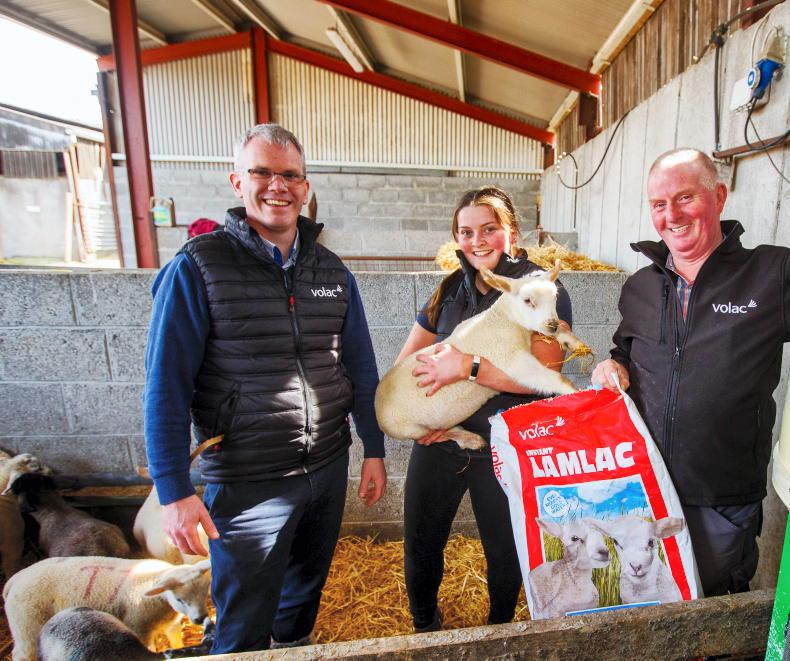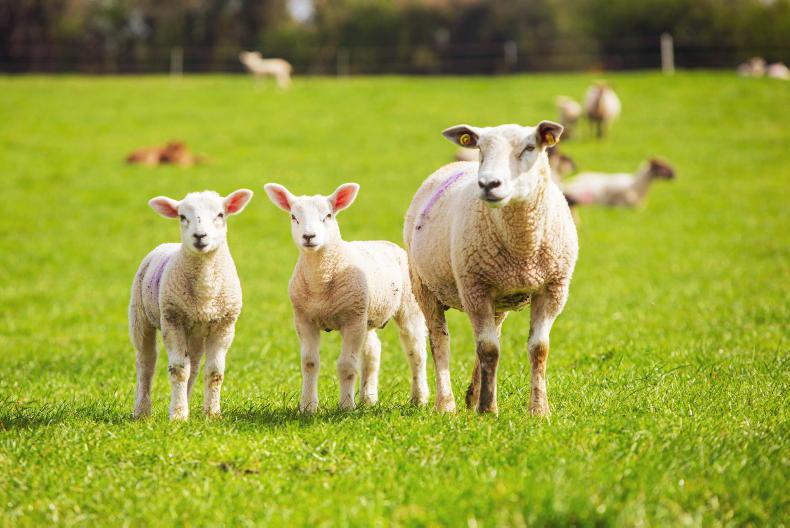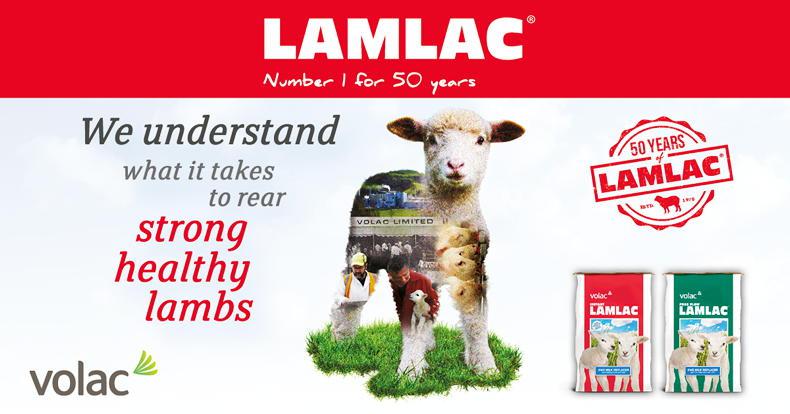While he also has 30 sucklers, the majority of Peadar’s time is spent tending to his 500-strong flock of Suffolk-cross-Texels.
“We tend to have a mid-season start, with lambing commencing in early March and a scanning average of 1.9 lambs per ewe,” said Peadar, who has used Lamlac® for over a decade.
“We rear an average of 40 lambs. Once the lamb is born, they’re placed into individual disinfected pens filled with dry bedding.
"Since they are born with little to no immunity, it’s essential that we provide lambs with sufficient levels of colostrum to provide them with the best possible start in life.
"Iodine is also applied to the lamb’s naval as soon as possible after birth and repeated a few hours later to minimise the risk of infection.”
Peadar continued: “I’m a long-time user of Lamlac® and I’ve been using an automatic lamb feeder since 2016, which is calibrated once a month. Our first lambs are generally drafted each June and we aim to have all lambs sold by Christmas.”

From left: JP Harkin (Volac Milk Replacer Ltd), Aoife Coyle and Peadar Coyle.
Lamlac® contains 24% protein and 24% oil and is formulated to supply all the essential elements required to maximise lamb performance.
Depending on the rearing system, a lamb reared to weaning at 35 days of age will require up to 13kg of Lamlac®, which equates to 52 litres of mixed milk replacer.
“We feed 10 to 12 kilogrammes of Lamlac® milk replacer to the lambs, with the amount determined by when we introduce them to the feeder, due to ad-lib feeding requiremnets,” said Peadar.
“When it comes to surplus lambs or for lambs which can fall behind a little once they’re out in the fields, all are fed on Lamlac®. Thanks to the quality of the feed, we regularly find ourselves in a position to sell some of those lambs come the first draft in June.”
According to Peadar: “We’ve found that lambs reared on Lamlac® perform as well as ewe-reared lambs.
"When I compare it to other products I’ve used previously and considering other factors, including mixability and performance, Lamlac® remains the market-leading product, one that I’ve been happy to use for many years and will continue to use.”
The efficacy of Lamlac® was underlined by the findings of an independent rearing study conducted by Harper Adams University (HAU) in the spring of 2021.
At HAU, 20 Suffolk Mule-cross-Texel surplus lambs were reared off the ewe on Lamlac®, recording impressive intake and growth rates.
On average, the lambs weighed 16.9kg (on abrupt weaning) at 35 days of age, achieving a daily liveweight gain up to weaning of 0.34kg per day.
These lambs were also given access to fresh water, creep feed and forage ad lib throughout the trial feeding period. Lamlac® was mixed at the rate of 200g of powder plus 800ml of water to give one litre of mixed milk.

Depending on the rearing system, a lamb reared to weaning at 35 days of age will require up to 13kg of Lamlac.
According to JP Harkin, Volac Milk Replacer Ltd’s regional business manager for northwest Ireland: “Trial results and on-farm experience also show that Lamlac® gives equally good performance other feeding systems including bottles."
Peadar Coyle described the level of contact and feedback from JP Harkin as “top-class, always of the highest order”.
He concluded: “JP is only ever a phone call away and nothing is ever a bother to him. I’ve great confidence in JP and the team and I know that should an issue arise during lambing, I’ll always get the best possible guidance and advice from Volac Milk Replacers Ltd.”
Expert advice from Volacn Milk Replacers Ltd
For more information on the benefits of feeding Lamlac®, contact your local Volac Milk Replacers Ltd business manager or click here.

While he also has 30 sucklers, the majority of Peadar’s time is spent tending to his 500-strong flock of Suffolk-cross-Texels.
“We tend to have a mid-season start, with lambing commencing in early March and a scanning average of 1.9 lambs per ewe,” said Peadar, who has used Lamlac® for over a decade.
“We rear an average of 40 lambs. Once the lamb is born, they’re placed into individual disinfected pens filled with dry bedding.
"Since they are born with little to no immunity, it’s essential that we provide lambs with sufficient levels of colostrum to provide them with the best possible start in life.
"Iodine is also applied to the lamb’s naval as soon as possible after birth and repeated a few hours later to minimise the risk of infection.”
Peadar continued: “I’m a long-time user of Lamlac® and I’ve been using an automatic lamb feeder since 2016, which is calibrated once a month. Our first lambs are generally drafted each June and we aim to have all lambs sold by Christmas.”

From left: JP Harkin (Volac Milk Replacer Ltd), Aoife Coyle and Peadar Coyle.
Lamlac® contains 24% protein and 24% oil and is formulated to supply all the essential elements required to maximise lamb performance.
Depending on the rearing system, a lamb reared to weaning at 35 days of age will require up to 13kg of Lamlac®, which equates to 52 litres of mixed milk replacer.
“We feed 10 to 12 kilogrammes of Lamlac® milk replacer to the lambs, with the amount determined by when we introduce them to the feeder, due to ad-lib feeding requiremnets,” said Peadar.
“When it comes to surplus lambs or for lambs which can fall behind a little once they’re out in the fields, all are fed on Lamlac®. Thanks to the quality of the feed, we regularly find ourselves in a position to sell some of those lambs come the first draft in June.”
According to Peadar: “We’ve found that lambs reared on Lamlac® perform as well as ewe-reared lambs.
"When I compare it to other products I’ve used previously and considering other factors, including mixability and performance, Lamlac® remains the market-leading product, one that I’ve been happy to use for many years and will continue to use.”
The efficacy of Lamlac® was underlined by the findings of an independent rearing study conducted by Harper Adams University (HAU) in the spring of 2021.
At HAU, 20 Suffolk Mule-cross-Texel surplus lambs were reared off the ewe on Lamlac®, recording impressive intake and growth rates.
On average, the lambs weighed 16.9kg (on abrupt weaning) at 35 days of age, achieving a daily liveweight gain up to weaning of 0.34kg per day.
These lambs were also given access to fresh water, creep feed and forage ad lib throughout the trial feeding period. Lamlac® was mixed at the rate of 200g of powder plus 800ml of water to give one litre of mixed milk.

Depending on the rearing system, a lamb reared to weaning at 35 days of age will require up to 13kg of Lamlac.
According to JP Harkin, Volac Milk Replacer Ltd’s regional business manager for northwest Ireland: “Trial results and on-farm experience also show that Lamlac® gives equally good performance other feeding systems including bottles."
Peadar Coyle described the level of contact and feedback from JP Harkin as “top-class, always of the highest order”.
He concluded: “JP is only ever a phone call away and nothing is ever a bother to him. I’ve great confidence in JP and the team and I know that should an issue arise during lambing, I’ll always get the best possible guidance and advice from Volac Milk Replacers Ltd.”
Expert advice from Volacn Milk Replacers Ltd
For more information on the benefits of feeding Lamlac®, contact your local Volac Milk Replacers Ltd business manager or click here.










 This is a subscriber-only article
This is a subscriber-only article






